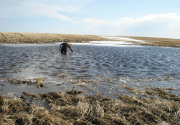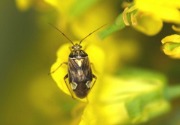| |
| |
 |
| |
 |
|
MMMM d, yyyy |
|
| |
 A recent study by the Prairie Agricultural Machinery Institute found two relatively minor changes in soybean harvest – reducing combine speed and investing in an air reel – can bring significant economic benefit to producers.
» Read more...
A recent study by the Prairie Agricultural Machinery Institute found two relatively minor changes in soybean harvest – reducing combine speed and investing in an air reel – can bring significant economic benefit to producers.
» Read more...
Bumblebees are less able to start colonies when exposed to a common neonicotinoid pesticide, according to a new University of Guelph study. The research found exposure to thiamethoxam reduces the chances of a bumblebee queen starting a new colony by more than one-quarter.
» Read more...
A third generation poultry farmer, Don Sundgaard says when it comes to succession, be patient, encourage off-farm experiences and welcome both formal and informal discussions. “Give it some time, but ask questions and have the conversations.”
» Read more...
|
| |
 |
 |
| |
|
| |
 If you read about neonicotinoids in the news, the context is likely the impact of this class of insecticides on pollinators. But according to Christy Morrissey, an associate professor at the University of Saskatchewan, there’s another side of the story that’s been neglected in the mainstream media. Since 2011, Morrissey has been studying the impact of neonics on Prairie wetlands.
» Read more...
If you read about neonicotinoids in the news, the context is likely the impact of this class of insecticides on pollinators. But according to Christy Morrissey, an associate professor at the University of Saskatchewan, there’s another side of the story that’s been neglected in the mainstream media. Since 2011, Morrissey has been studying the impact of neonics on Prairie wetlands.
» Read more... |
| |
 With more vigorously growing canola crops, higher yield and relatively high prices, new research has found the current economic threshold level of approximately one lygus bug per sweep to be too low. Héctor Cárcamo, a research scientist with Agriculture and Agri-Food Canada, says using a higher threshold may reduce pesticide use in canola crops and produce significant cost savings for growers.
» Read more...
With more vigorously growing canola crops, higher yield and relatively high prices, new research has found the current economic threshold level of approximately one lygus bug per sweep to be too low. Héctor Cárcamo, a research scientist with Agriculture and Agri-Food Canada, says using a higher threshold may reduce pesticide use in canola crops and produce significant cost savings for growers.
» Read more... |
| |
 |
| |
|
| |
September 12-14, 2017
Location: Woodstock, Ont.
» Learn More
|
| |
| |







